Generally the peltae are arranged in groups of four. Two standing and two lying peltae touch one another with their external tips. Thus heart-shaped fields arise. In every fourth point of the pattern a semi-circle appears, in the first row alternating upwards and downwards, in the second row to the right and to the left. In this way a framework arises featuring forms that resemble scales into which two smaller semi-circles are inserted (Fig. 28).
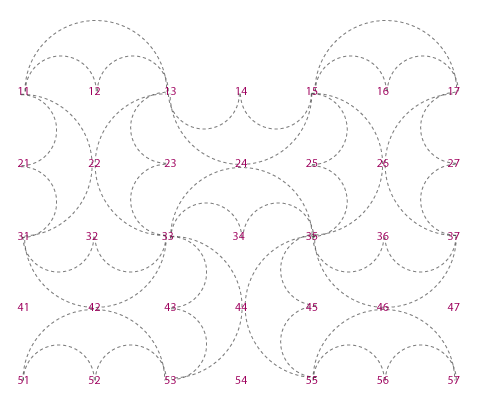 |
Peltae in groups of four can appear as a repeat pattern on a larger surface or central area, or be limited to a smaller space. An isolated group of four as filler motif is very seldom in Greece. The pelta pattern was generally one of black or blue upon a white background (Fig. 29).
 |
The pattern’s monotonous aspect was often offset by more brightly coloured, usually red peltae. In some cases the colour can no longer be precisely determined as only black-and-white photos or inexact drawings of the mosaics were published.
On several pavements groups of four dark peltae appear on a white background. In rare cases pink groups of four appear with a black contour around them.
Unique among mosaics thus far discovered is a composition in Olympia. Here a design of lightly coloured peltae surrounds a central area consisting of nine dark pelta pairs (Fig. 30).
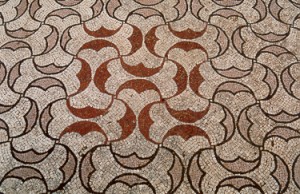 |
An apparent speciality of Peloponnese workshops is the combination of red and black peltae. The design is such that two differently coloured peltae always lie opposite, or with their backs to one another. The surface pattern consists of simple pelta forms with unembellished endings (Fig. 31).
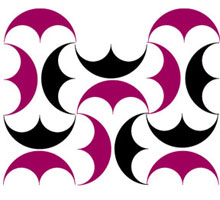 |
On a mosaic from Corinth two differently coloured peltae feature an apex consisting of three tessallae arranged parallel to one another.
On another mosaic from Corinth groups of four black and red peltae also appear. Their apex is decorated by three tessellae arranged in a V-shape.
A strikingly similar pelta design can be found on a mosaic in Argos. Two black and two lighter peltae (probably grey or pink) make up a group of four. They feature a cross-shaped apex consisting of five tessellae.
A mosaic from Patras can also probably be classified as part of this group, though up to now only an inconclusive drawing of the mosaic has been published.
In this case it’s possible that the peltae have only a single colour and a cross-shaped apex.
Unique up to now are the rather more complex pelta compositions in Eleusis and Kos. In Eleusis the groups of four appear in two colours (probably black and red), with handles that fold inwards and a heart-shaped apex. The decoration of the middle endings is absent from the peltae along the edges (Fig. 32).
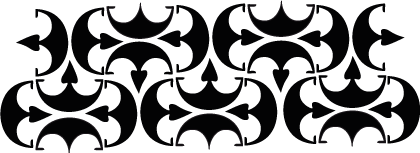 |
The peltae on the pavement in Kos have a V-shaped apex. The pattern features three colours (blue, yellow and red) upon a white background. Dark blue peltae frame red and yellow pairs. (Fig. 33). Around the edges small rectangles, also in different colours, appear between the peltae.
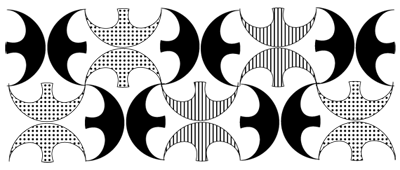 |